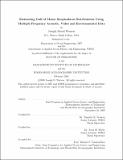Estimating Gulf of Maine zooplankton distributions using multiple frequency acoustic, video and environmental data
Author(s)
Warren, Joseph David
DownloadFull printable version (17.04Mb)
Other Contributors
Woods Hole Oceanographic Institution.
Advisor
Timothy K. Stanton and Peter H. Wiebe.
Terms of use
Metadata
Show full item recordAbstract
This thesis develops methods useful for estimating zooplankton distributions in the field by combining acoustic scattering models and an integrated set of field data. The accuracy of existing scattering models for fluid-like and elastic-shelled animals is determined by analysis of scattering data from individual animals in a laboratory tank. Results indicate that simple two-ray scattering models are accurate and allow predictions of size or orientation of an animal to be made for certain animal orientations. A scattering model for gas-bearing zooplankton is compared with in situ multiple frequency acoustic measurements from siphonophores. Estimates of the numerical density of these animals are made using echo integration data from a scientific echo-sounder. Multiple frequency acoustic scattering data from a survey of an internal wave are analyzed to determine the contributions from biological and physical sources. Net tow data provide information about biological scatterers while temperature and salinity profiles are used with a theoretical scattering model to predict contributions from physical sources. Results indicate that scattering from physical sources is comparable to that from biological sources in certain regions and that scattering spectra may be used to distinguish these sources. Improved estimates of biomass from acoustic scattering data were made by accounting for the scattering contributions from physical sources. This is the first work to quantify the scattering contributions from biological and physical sources of scattering in a field study.
Description
Thesis (Ph.D.)--Joint Program in Applied Ocean Science and Engineering (Massachusetts Institute of Technology, Dept. of Ocean Engineering and the Woods Hole Oceanographic Institution), February 2001. Includes bibliographical references (p. 211-219).
Date issued
2001Department
Joint Program in Applied Ocean Physics and Engineering; Woods Hole Oceanographic Institution; Massachusetts Institute of Technology. Department of Ocean EngineeringPublisher
Massachusetts Institute of Technology
Keywords
Ocean Engineering., /Woods Hole Oceanographic Institution. Joint Program in Applied Ocean Science and Engineering., Woods Hole Oceanographic Institution.